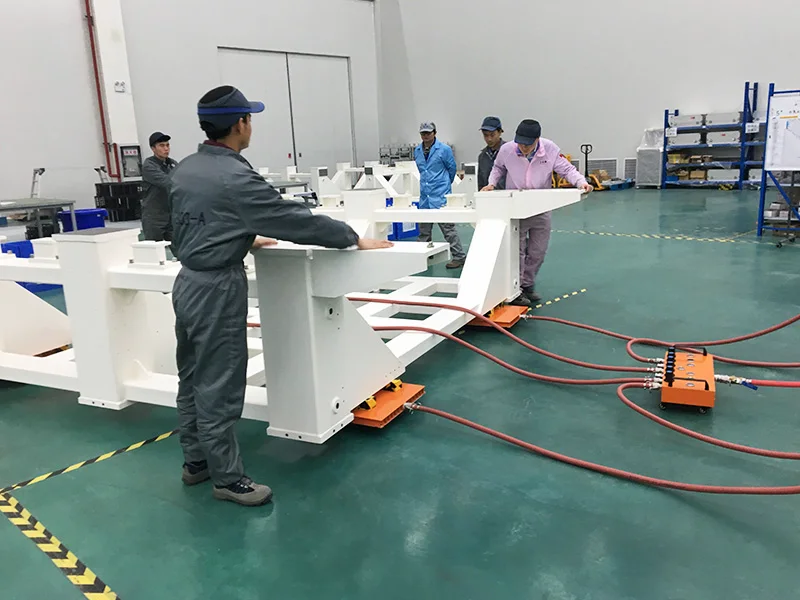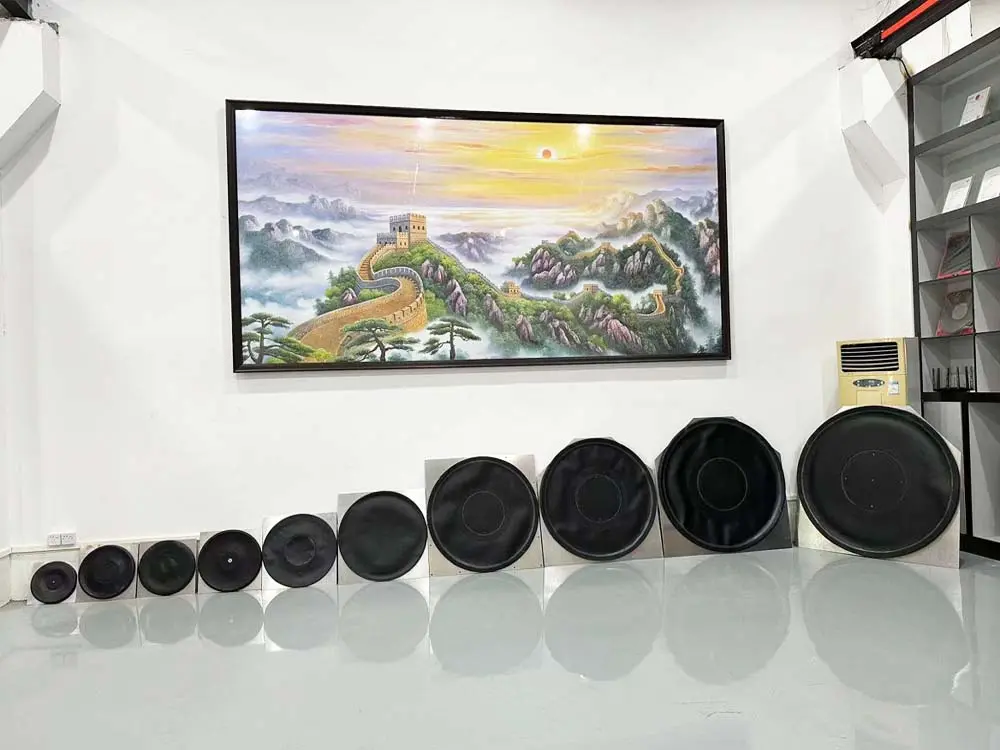
Air casters deliver superior performance to ordinary wheels because they protect floors and handle all directional movements while needing reduced physical strength. It should be kept in mind that the balloon has 15-60 psi pressure inside it. Air casters use air to lift heavy loads, allowing them to move easily with little effort, making them ideal for factories and warehouses.
Air caster systems enable the easy movement of heavy loads with minimal force. These devices can work well with other equipment, keep loads on the ground, and are straightforward to use. Air casters are very important for industries where you need to move heavy loads and types of equipment. The initial cost of an air caster may be high, but it proves economical in the long run. These devices help move heavy loads while maintaining floor consistency and the safety of the operators. The primary purpose of this article is to give you basic information regarding air casters, why you should use them, their applications, and tasks that can be made easy by using these devices.
Define Air Casters: Reasons for Using Air Casters
Air casters lift heavy loads using air pressure or a thin air film between the floor and the object. The machine, weighing 5,000 pounds, can be moved by 25 pounds of force. This technique makes it possible to carry large objects without being hurt or utilising more labor. People should be aware that using air casters is highly beneficial, as this equipment effectively moves heavy objects, provides ergonomic support, and enhances safety. The main factor in moving an object from one place to another is friction, which is reduced by using air casters. In factories, heavy objects must be moved from one place to another. Air casters are easy to handle and manage. This device enables heavy loads to float on the surface; the air film between the air caster system and the floor allows the object to move flawlessly.
Essential Things to Take Into Account While Selecting Air Casters
When buying and utilising an air caster, the following considerations should be made:
- Load Capacity
- Floor Conditions
- Air Supply Requirements
- Material Type
- Size and Portability
Load Capacity
The weight these devices can raise is the air caster’s load capacity. The rough estimate of the load capacity of the air caster is a few hundred kg to 20 tons. Some of the systems are designed to move objects weighing even 200,000 tons. A single air caster can bear a weight of up to 1000 pounds. The workers should learn that the load capacity of the air caster depends on the number of air casters used. If you need to move a heavy load, you can increase the number of air casters. Also, load capacity depends on the air pressure it generates and the surface on which the air caster system moves.
Floor Conditions
Inspecting the place first is essential when using air casters in an industry or warehouse, which means assessing the floor conditions. The floor’s surface should be smooth so the air casters work correctly. Air casters pose minimal pressure on the floor and minimal damage to the floor. A rough floor surface requires more air to maintain the smooth air film of 0.002-0.005mm between the air caster balloon and the floor. Using a device like that for moving heavy-duty objects is very beneficial.
Air Supply Requirements
A constant air supply is required to properly function the air casters. The pressure is around 25 Psi, meaning air at low pressure is required to move an object. The pressure of the air is directly proportional to the object’s weight; air at high pressure is required to move a heavy object. You may require 40–60 cubic feet per minute (CFM) at 60–80 PSI (pounds per square inch) for a 10,000-pound load on a smooth floor. Similarly, high-pressure air is required for moving objects on a rough floor surface.
Material Type
There are two kinds of material used in making air casters: polyurethane and rubber. Polyurethane material can withstand the pressure required to move a load of 177000 pounds. At the same time, rubber can withstand low pressure and carry a weight of around 23000 pounds. The air casters from this material suffer very little wear and tear, requiring almost no maintenance. On the other hand, the surface material on which an air caster can work should be smooth, non-porous, and free from any kind of foreign material. Epoxy and concrete floors are preferred for optimal functioning.
Size and Portability
Various sizes of air casters are available based on industry requirements. Try to select the size suitable for your task. Air casters are 1 inch to 2 inches in height. If you need an air caster that can lift many tons, you need one that can support heavy weights. The air casters can adjust in small places and have a 360-degree capacity, so select the air caster according to your place’s requirements.

Matching Air Casters to Your Factory Needs
It is crucial to match the air caster with the factory’s specific needs when one is required. Certain factors must be considered while matching this requirement. An ideal air caster requires minimal effort to move heavy loads.
Type of Load
Understanding the kind of load that can be lifted with the air casters, whether heavy or light. These devices can lift various loads, and factory workers must assess whether the material is fragile, the air pressure requirement for the load, and the surface area.
Movement Frequency
If the movement frequency is high, the air caster reduces labor costs and saves the time required to move a heavy load. The low movement frequency of the material is costly.
Space Constraints
An air caster can work in confined spaces, as it has a 360-degree movement ability, so a smaller space causes no hindrance to the work. A factory on a smaller level can use an air caster.
Budget
Using an air caster system with high-frequency movement for a longer time may be a cost-effective solution. Due to the initial high cost, a convey belt is a more suitable option on a smaller level.
Practical Tips for Choosing and Using Air Casters
Whether or not a piece of equipment is useful, it is necessary to evaluate its practicality. These useful pointers can help you choose an air caster design.
Calculate Your Load
A basic tip is to measure the load that can be moved using an air caster solution. Try to obtain an exact estimate of the number of casters required to move a specific load of material. Afterward, you can get an ideal air caster rigging system for practical use.
Test Your Floor
Examining the floor is another practical step in using an air caster. Check the floor for cracks or slop. If the floor slopes 0.25 inches over 10 feet, it is very hard to handle the load. The floor must be very smooth for the optimal functioning of air casters.
Check Air Supply
The constant air supply from the source is suitable for the air caster. Try to check the compressor and the PSI rating because if the air caster does not have the appropriate air supply, it may ruin the whole system.
Start Small
It is usually suggested that before investing in a larger project, starting with a smaller scale is beneficial. Different varieties of the air caster price ranges, as initial packages, are around 1000-2000$, which are way less than 5000$.
Train Your Team
Operators must acquire skills and get proper training to operate air casters safely. They must prepare floors and execute safe load movements. They need to understand standard troubleshooting procedures and emergency response protocols. Regular safety training refreshers should be provided to operators. Some written instructions and resources should be distributed to them. The system requires expert supervision for proper operation because training plays a vital role.
The Advantages of Finer Brand Air Casters Make Them the Ideal Choice
All products from Finer Brand are designed to exceed industry requirements for present-day industrial usage with exceptional performance. The air caster ranges from 10 to 120 tons to support delicate precision machinery and massive industrial equipment. The durable construction of air casters uses tested materials to achieve extended operational life in harsh conditions. Our company develops personalised solutions because we understand that each client has distinct handling requirements. The Finer Brand Battery-Powered Machine Skates work perfectly with Finer Brand air casters to create a complete system that delivers effortless equipment movement with precision and efficiency.
Conclusion
Selecting appropriate air casters requires knowledge of your load weight, floor conditions, air supply availability, and available space. These devices minimise floor friction while providing protection and safety for heavy equipment movement through effortless operations. Finer Brand Air Casters excel through their strong load-bearing capabilities, sturdy construction, and ability to work with advanced tools, including battery-powered machine skates. Your facility can achieve a customised solution through available customisation options.
